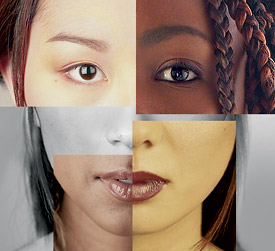Few subjects provoke as strong a visceral response as the topic of race. One-hundred-fifty years after the United States was nearly fractured by the battle over slavery and more than a half-century since the modern Civil Rights Movement emerged, U-M is launching the Understanding Race Project.
From January through April, an extensive range of free public exhibits, performances, lectures, symposia and more than 130 courses in several disciplines will explore the concept of race and its impacts. The historical, cultural, psychological and legal interpretations of race will be examined from both national and global perspectives.

Photo by Milagros González.
Highlights of the project include the “Race: Are We So Different?” exhibit developed by the American Anthropological Association and the Science Museum of Minnesota, which opens Feb. 9 at the U-M Museum of Natural History and “IndiVisible: African Native American Lives in the Americas,” a Smithsonian Institution Traveling Exhibit, which opened Jan. 9 at the Duderstadt Center Gallery on North Campus.
On Jan. 21, Morris Dees, co-founder of the Southern Poverty Law Center will deliver the keynote lecture for the Dr. Martin Luther King Jr. Memorial Symposium at 10 a.m. at Hill Auditorium. At 2 p.m., in the Rogel Ballroom of the Michigan Union, Angela Davis, educator and civil rights activist will speak about prisons. They are among the dozens of lecturers speaking at U-M as part of the project.
National Public Radio personality Michele Norris will bring a special edition of her Race Card Project to campus later in the semester, asking participants to submit a six word statement about race on post cards or the Web. In April she will return for a residency, including meetings with students and a display of the cards on the Diag on April 18.
The Understanding Race Winter 2013 Theme Semester is part of the project and offers courses that examine national and global ideas about race as well as challenges to racism. Dozens of symposia, lectures and other events are included as part of the semester, which is sponsored by LSA.
“This project is as broad and varied as the cultural and ethnic groups that constitute, define and sometimes divide the human family here and around the globe,” says Amy Harris, co-chair of the Understanding Race Project and director of U-M Museum of Natural History (UMMNH).
The project is beginning as racial prejudice is increasing in the United States, with 51 percent of Americans expressing anti-black attitudes in October 2012, compared with 48 percent in 2008, according to recent polls by the Associated Press.
The “Race: Are We So Different?” exhibit at UMMNH will be the cornerstone for the theme semester. Visitors will see a mosaic of photos, graphics, interactive displays and artifacts to learn about the history of the idea of race and to evoke an everyday portrait of what it means to live with race as a reference for personal identity, cultural construct and political constituency.
More than 130 courses in psychology, history, anthropology, gender studies, Afroamerican and African studies and other disciplines will incorporate race and related subjects.
In November, UMMNH opened the “Race in This Place” exhibit featuring video conversations about race with Washtenaw County residents. The Understanding Race Project engages community residents and organizations, and involves all 10 public school districts in the county.
“The conversation about race is local, but the critical debate about race is international,” says Harris, who noted “Understanding Race” would continue after the semester ends in April. “This is a healthy, positive public discussion, regardless of your race and ethnicity, and we look forward to an extended conversation with the community.”
For more information go to www.understandingraceproject.org.

